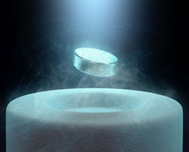

Context
Recently, two South Korean researchers proposed papers, claiming that a ‘lead-based compound’ developed by them had shown superconducting properties at room temperature, under normal pressure conditions.
- The discovery has the potential to revolutionize the technology space, and be one of the most impactful scientific discoveries of this century.
|
The first material to have been discovered to show super conductive properties was Mercury, which becomes a superconductor at close to 270 degree Celsius below zero. |
What is Superconductivity?
- Superconductivity refers to a state in which a material offers zero, or near-zero, resistance to electric current.
- A current is nothing but the movement of charged particles, electrons in most cases, in a particular direction. When the electrons move, they collide, and interact, with other atoms in the material.
- The current flowing encounters resistance which is an essential property in electrical conductivity.
- Resistance involves a loss of energy, mostly in the form of heat. This is the reason why electrical appliances get heated is this resistance.
What are Superconducting materials?
- Most of the other materials commonly used as superconductors are Lead, Aluminum, Tin, Niobium, and several others –at comparable temperatures, called critical temperature.
- There are several elements that show superconductivity at higher temperatures like up to 150 degrees.
- Scientists are looking for a material that can display superconductivity at room temperature (usually considered to be between 20 and 25 degree Celsius) and under normal pressure conditions.
How Superconductivity helps?
- Elimination of the electric resistance can result in super-efficient electrical appliances like removal of transmission losses in power cables, and massive gains in energy.
- Also, Superconducting materials show very interesting behaviour under magnetic field which allows the functioning of systems like the MRI scan machine and the superfast Maglev trains that float above the tracks.
- Superconductors have very critical uses in a wide variety of other scenarios as well.
What are the existing issues faced to induce superconductivity?
- As of now, superconductivity can be achieved only at very low temperatures, more than 250 degree Celsius below zero, very close to absolute zero which is – 273 degree Celsius.
- Additionally, some compounds are difficult to be produced; they are brittle and chemically unstable.
- The need of low temperatures for the materials to become superconductive, close to the absolute zero, which results in high operating costs.
Why the discovery of Room temperature conductivity significant?
- It has applications in magnetic resonance imaging (MRI) machines, low-loss power lines, and ultra-powerful superconducting magnets to mobile-phone towers.
- Researchers are also experimenting with them in high-performance generators for wind turbines.
Other researches related to superconducting materials:
- Recently, the researchers have created a material that is superconducting at room temperature, however, it only works at a pressure of 267 Gigapascals (GPa), which is equivalent to about three-quarters of pressure at the centre of Earth (360 GPa).
- Material Used: A mixture of carbon, hydrogen and sulfur was put in a microscopic niche carved between the tips of two diamonds (diamond anvil) and laser light was used on them to trigger chemical reactions.
|
India’s steps in similar direction:
|

